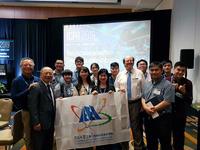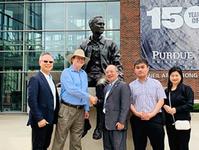Professor Nof, IE PhD students Puwadol O. Durasdeerungsikul and Win P.V. Nguyen, and IE alum Ashwin S. Nair (MSIE 2019) are members of the Production, Robotics, & Integration Software for Manufacturing and Management (PRISM) Center.
-
Durasdeerungsikul's presentations were titled, "Collaboration Requirement Planning Protocol for HUB-CI in Factories of the Future" and "Collaborative Control Protocol for Agricultural Cyber-Physical System"
-
Nguyen's presentations were titled: "Collaborative Response to Disruption Propagation with Established Lines of Collaboration (CRDP/ESLOC) in Cyber-Physical Systems: Informatics for Decision Support" and "Advancing Cyber-Physical Systems Resilience: The Effects of Evolving Disruptions"
-
Nair's presentation was titled: "The HUB-CI model for telerobotics in greenhouse monitoring"
The 25th International Conference on Production Research - Manufacturing Innovation: Cyber Physical Manufacturing Conference took place in Chicago from Aug. 9-14, 2019.
Following the conference, Purdue IE alumnus Professor Chin-Yin Huang of Tunghai University in Taiwan and ten of his students visited the PRISM Center and the School of Industrial Engineering. Dr. Huang is Professor and Department Chair of Industrial Engineering and Enterprise Information at Tunghai University, Taiwan, and holds a PhD degree from Purdue University.
ABSTRACTS
Collaboration Requirement Planning Protocol for HUB-CI in Factories of the Future
Puwadol Oak Dusadeerungsikul, Maitreya Sreeram, Xiang He, Ashwin Nair, Karthik Ramani, Alexander J. Quinn, Shimon Y. Nof
Rapid advances in production systems’ models and technology continually challenge manufacturers preparing for the factories of the future. To address the complexity issues typically coupled with the improvements, we have developed a brain-inspired model for production systems, HUBCI. It is a virtual Hub for Collaborative Intelligence, receiving human instructions from a human-computer interface; and in turn, commanding
robots via ROS. The purpose of HUB-CI is to manage diverse local information and real-time signals obtained from system agents (robots, humans, and warehouse components, e.g., carts, shelves, racks) and globally update real-time assignments and schedules for those agents. With Collaborative Control Theory (CCT) we first develop the protocol for collaborative requirement planning for a HUB-CI, (CRP-H), through which we can synchronize the agents to work smoothly and execute rapidly changing tasks. This protocol is designed to answer: Which robot(s) should perform each human-assigned task, and when should this task be performed? The primary two phases of CRP-H, CRP-I (task assignment optimization) and CRP-II (agents schedule harmonization) are developed and validated for two test scenarios: a two-robot collaboration system with five tasks; and a two-robot-and-helper-robot collaboration system with 25 tasks. Simulation results indicate that under CRP-H, both operational cost and makespan of the production work are significantly reduced in the two scenarios. We summarize with the implications and future plans for integrating HUB-CI and CRP-H in a cyber-augmented physical simulation model.
Collaborative Control Protocol for Agricultural Cyber-Physical System
Puwadol Oak Dusadeerungsikul, Shimon Y. Nof, Avital Bechar, and Yang Tao
In this article, a Collaborative Control Protocol for Robotic and Cyber-Physical System (CCP-CPS) is presented. CCP-CPS, which enables an application of robotics in a CPS system for smart and precision agriculture (PA), aims to monitor and identify stresses in greenhouse crops by a hyperspectral analysis method. Roles of CCP-CPS are to assign tasks to agents, identify and resolve conflicts and errors in the system, and enable a more effective collaboration and interaction among agents in CPS, compared to traditional non-collaborative and non-CPS approach. Collaborative Control Theory (CCT) is utilized for two system levels; protocol and agent level (CCP level), and CPS and environment level (CPS level). We use two case studies to test and validate our method with alternative approaches. The results from computer simulation show that 1) CCP-CPS can identify the highest number of greenhouse locations containing stresses, 2) CCP-CPS can utilize available resources (time) effectively, and 3) CCP-CPS can respond to an emergency stress situation faster and have more tolerance capability with system conflicts and errors, by having human integration and cyber-augmented greenhouse system, than other monitoring systems.
Collaborative Response to Disruption Propagation with Established Lines of Collaboration (CRDP/ESLOC) in Cyber-Physical Systems: Informatics for Decision Support
Win P. V. Nguyen, Shimon Y. Nof
The interconnectedness and complexity of cyber-physical systems (CPSs) provide greater quality of service, productivity, and flexibility. On the other hand, the high levels of interactions, communications, and dependencies within CPSs also increase their vulnerabilities to disruptions and targeted attacks. Disruptions in one part of a CPS can propagate to another part, eventually compromising the entire CPS if protective mechanisms and preparations are insufficient. This challenge is addressed in this work with the Collaborative Response to Disruption Propagation with Established Lines of Collaboration (CRDP/ESLOC) model. The CRDP/ESLOC model simulates the effects of disruption propagation on a CPS and provides informatics on the disruptions' behaviors. The CRDP/ESLOC model also analyzes the possible strategic decisions of allocating prevention resources and recovery resources to contain and mitigate the disruptions, and recover the CPS for continuity of service. The new disruption propagation informatics and protocols, categorized as centrality-based and coverage-based, are simulated and validated with a network model based on an industrial CPS. The experiment shows that coverage-based informatics and protocols provide higher CPS prevention and recovery resilience, and thus, should be further developed in future work.
Advancing Cyber-Physical Systems Resilience: The Effects of Evolving Disruptions
Win P. V. Nguyen, Ashwin S. Nair, Shimon Y. Nof
Highly interconnected cyber-physical systems (CPSs) and complex networks can enable greater production capabilities and quality of life through their cyber-augmented characteristics. The high level of interconnectedness within CPSs, however, also increases their vulnerabilities to intelligent malware and coordinated attacks. A disrupted part of a CPS can not only cease to function properly, it can also increase the vulnerability of other parts of the CPS due to the interconnections. In this research, we expand on our previous work, the Collaborative Response against Disruption Propagation (CRDP) model and explore the effects of intelligently coordinated attacks on CPSs. This work addresses a severe limitation of the CRDP model: The assumption that disruptions have random targets. In this new work, the adversarial disruption network initially has only limited information about the target CPS network and assumes random targets. Over time, the adversarial disruption network is assumed to utilize decision tree learning algorithm to intelligently learn about the CPS's response capabilities over time. Then, the disruption network utilizes this learning to improve its attacks by the defense targeting and response protocols. The novel adversarial disruption learning and targeting protocols are simulated and validated with a random network model. The experiments show that the developed protocols defending the disrupted network can significantly stress the CPS's resilience capabilities. Further research is needed to understand how the role of cyber-collaborative protocols can advance the CPS resilience.
The HUB-CI model for telerobotics in greenhouse monitoring
A.S. Nair, A. Bechar, Y. Tao, and S.Y. Nof
Networked telerobots are operated by humans through remote interactions and have found applications in hazardous and/or unstructured environments, such as outer space, underwater, telesurgery, manufacturing, and production. In precision agricultural robotics, target monitoring, recognition, and detection is a complex task, requiring expertise. Hence, they can be more efficiently performed by collaborative human-robot systems. A HUB is an online portal, a platform to create and share scientific and advanced computing tools. Multiple HUBs have been developed recently for scientific research objectives. HUB-CI is a tool developed by PRISM Center at Purdue University to enable cyberaugmented collaborative interactions over cyber-supported complex systems. The research reported here, sponsored in part by BARD, implements the HUB-CI model to improve the Collaborative Intelligence (CI) of an agricultural telerobotic system for early detection of anomalies in pepper plants grown in greenhouses. Specific CI tools developed
for this purpose include: (1) spectral image segmentation for detecting and mapping to anomalies in growing pepper plants; (2) workflow/task administration protocols for managing/coordinating interactions between software, hardware, and human agents, engaged in the monitoring and detection, which would reliably lead to precise, responsive mitigation. These CI tools aim to minimize interactions’ conflicts and errors that may impede detection effectiveness, thus reducing crops’ quality. On-going lab and field experiments indicate that planned and optimized collaborative interactions with HUB-CI (as opposed to ad-hoc or fixed-structured interactions) yield significantly fewer errors and better detection. Hence, it improves system productivity of precise monitoring for healthy growth of pepper plants in greenhouses.


